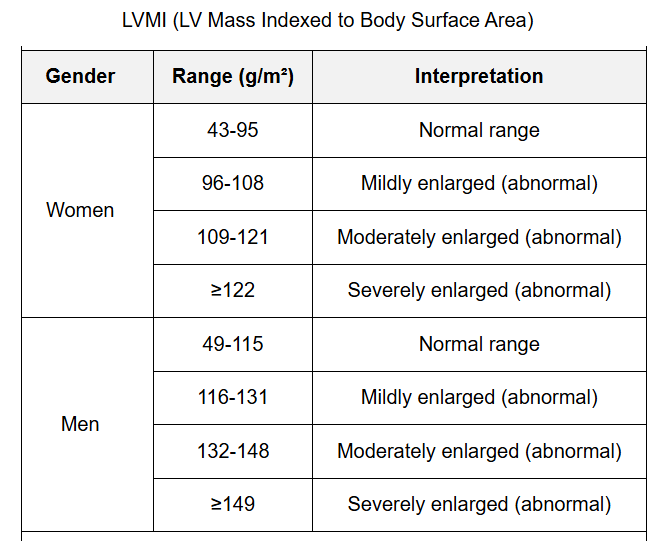1. What is a Left Ventricular Mass Index Calculator?
Definition: This calculator computes the Left Ventricular Mass (LVM), Left Ventricular Mass Index (LVMI), and Relative Wall Thickness (RWT) of the heart, given the Left Ventricular End-Diastolic Dimension (LVEDD), Interventricular Septal thickness at end-diastole (IVSd), Posterior Wall thickness at end-diastole (PWd), and Body Surface Area (BSA). If BSA is not known, it can be calculated from height and weight.
Purpose: It aids in medical assessments by evaluating heart size and geometry, helping to diagnose conditions like left ventricular hypertrophy, which is linked to cardiovascular risks such as heart failure and coronary disease.
| Left Ventricular Mass Measurements in Echocardiography |
| LVMI (LV Mass Indexed to Body Surface Area) |
| Gender |
Range (g/m²) |
Interpretation |
| Women |
43-95 |
Normal range |
| 96-108 |
Mildly enlarged (abnormal) |
| 109-121 |
Moderately enlarged (abnormal) |
| ≥122 |
Severely enlarged (abnormal) |
| Men |
49-115 |
Normal range |
| 116-131 |
Mildly enlarged (abnormal) |
| 132-148 |
Moderately enlarged (abnormal) |
| ≥149 |
Severely enlarged (abnormal) |
| RWT (Relative Wall Thickness) Interpretation |
If LVMI exceeds normal (women >95 g/m², men >115 g/m²):
- RWT >0.42 — Concentric hypertrophy
- RWT ≤0.42 — Eccentric hypertrophy
If LVMI normal (women ≤95 g/m², men ≤115 g/m²):
- RWT >0.42 — Concentric remodeling
- RWT ≤0.42 — Normal heart
|
| Other Echocardiographic Measurements |
| Measurement |
Typical Values |
| LVEDD (Left Ventricle End Diastolic Dimension) |
39-56 mm |
| IVSd (Interventricular Septal end Diastole measurement) |
0.6-1.1 cm |
| PWd (Posterior Wall thickness at end-Diastole) |
0.6-1.1 cm |
2. How Does the Calculator Work?
The calculator takes the following inputs and computes:
- Body Surface Area (BSA):
- If not known: \( \text{BSA} = \sqrt{\frac{\text{height (cm)} \times \text{weight (kg)}}{3600}} \), in m².
- Otherwise, uses the provided BSA value, converted to m².
- Left Ventricular Mass (LVM):
- Formula: \( \text{LVM} = 0.8 \times \{1.04 \times [(\text{LVEDD} + \text{IVSd} + \text{PWd})^3 - \text{LVEDD}^3]\} + 0.6 \), in grams, with dimensions in cm.
- Left Ventricular Mass Index (LVMI):
- Formula: \( \text{LVMI} = \text{LVM} / \text{BSA} \), in g/m² (converted to selected unit).
- Relative Wall Thickness (RWT):
- Formula: \( \text{RWT} = \frac{2 \times \text{PWd}}{\text{LVEDD}} \), unitless.
Unit Conversions:
- Length: cm, m, in, ft (e.g., 1 m = 100 cm = 39.3701 in = 3.28084 ft).
- Weight: kg, lb, oz (e.g., 1 kg = 2.20462 lb = 35.274 oz).
- Area: cm², m², in², ft² (e.g., 1 m² = 10000 cm² = 1550.0031 in²).
- Mass: g, oz, lb (e.g., 1 g = 0.035274 oz = 0.00220462 lb).
- Mass per Area: g/m², g/in², g/ft² (e.g., 1 g/m² = 0.00064516 g/in²).
Steps:
- Select the patient’s sex (female or male).
- Indicate if BSA is known; if not, provide height and weight with selected units.
- Input LVEDD, IVSd, and PWd with selected units (cm, m, in, ft).
- Compute BSA (if needed), LVM, LVMI, and RWT, converting to selected output units.
- Display results formatted to 4 decimal places.
3. Importance of Left Ventricular Mass Index Calculations
Calculating LVMI and RWT is crucial for:
- Cardiology: Assessing the risk of cardiovascular events like heart failure, as increased LVMI is an independent predictor of adverse outcomes.
- Hypertension Management: Identifying left ventricular hypertrophy in hypertensive patients, which may necessitate treatment adjustments.
- Diagnosis: Classifying cardiac hypertrophy as concentric (RWT > 0.42) or eccentric (RWT ≤ 0.42 with increased LVMI).
4. Using the Calculator
Examples:
- Female, BSA Known: BSA = 1.6 m², LVEDD = 1 cm, IVSd = 0.6 cm, PWd = 0.1 cm
LVM: \( 0.8 \times \{1.04 \times [(1 + 0.6 + 0.1)^3 - 1^3]\} + 0.6 \approx 3.8600 \, \text{g} = 0.1362 \, \text{oz} \).
LVMI: \( 3.86 / 1.6 \approx 2.4125 \, \text{g/m}^2 = 0.0016 \, \text{g/in}^2 \).
RWT: \( (2 \times 0.1) / 1 = 0.2000 \).
- Female, BSA Unknown: Height = 160 cm, Weight = 55 kg, LVEDD = 1 cm, IVSd = 0.6 cm, PWd = 0.1 cm
BSA: \( \sqrt{(160 \times 55) / 3600} \approx 1.5635 \, \text{m}^2 = 24233.2500 \, \text{cm}^2 \).
LVM: \( 3.8600 \, \text{g} \).
LVMI: \( 3.86 / 1.5635 \approx 2.4685 \, \text{g/m}^2 \).
RWT: \( 0.2000 \).
- Male, BSA Known: BSA = 1.8 m², LVEDD = 1 cm, IVSd = 0.6 cm, PWd = 0.1 cm
LVM: \( 3.8600 \, \text{g} = 0.0085 \, \text{lb} \).
LVMI: \( 3.86 / 1.8 \approx 2.1444 \, \text{g/m}^2 = 0.0231 \, \text{g/ft}^2 \).
RWT: \( 0.2000 \).
- Male, BSA Unknown: Height = 175 cm, Weight = 70 kg, LVEDD = 1 cm, IVSd = 0.6 cm, PWd = 0.1 cm
BSA: \( \sqrt{(175 \times 70) / 3600} \approx 1.8442 \, \text{m}^2 \).
LVM: \( 3.8600 \, \text{g} \).
LVMI: \( 3.86 / 1.8442 \approx 2.0929 \, \text{g/m}^2 \).
RWT: \( 0.2000 \).
5. Frequently Asked Questions (FAQ)
Q: What do LVMI values indicate?
A: LVMI measures heart size relative to body size. Normal ranges are 43–95 g/m² for females and 49–115 g/m² for males. Values above these (e.g., 109–121 g/m² for females, 132–148 g/m² for males) indicate moderate hypertrophy, suggesting increased cardiovascular risk.
Q: What does RWT tell us?
A: RWT assesses heart geometry. Values between 0.32 and 0.42 are normal. Above 0.42 suggests concentric hypertrophy (thicker walls), while ≤0.42 with high LVMI indicates eccentric hypertrophy (larger heart chamber).
Q: Why can I choose different units for measurements?
A: The calculator allows flexible unit selection for height, weight, LVEDD, IVSd, PWd, BSA, LVM, and LVMI to accommodate various measurement systems, converting all inputs to standard units (m, kg, cm, m², g) for calculations.
Left Ventricular Mass Index Calculator© - All Rights Reserved 2025
 Home
Home
 Back
Back
